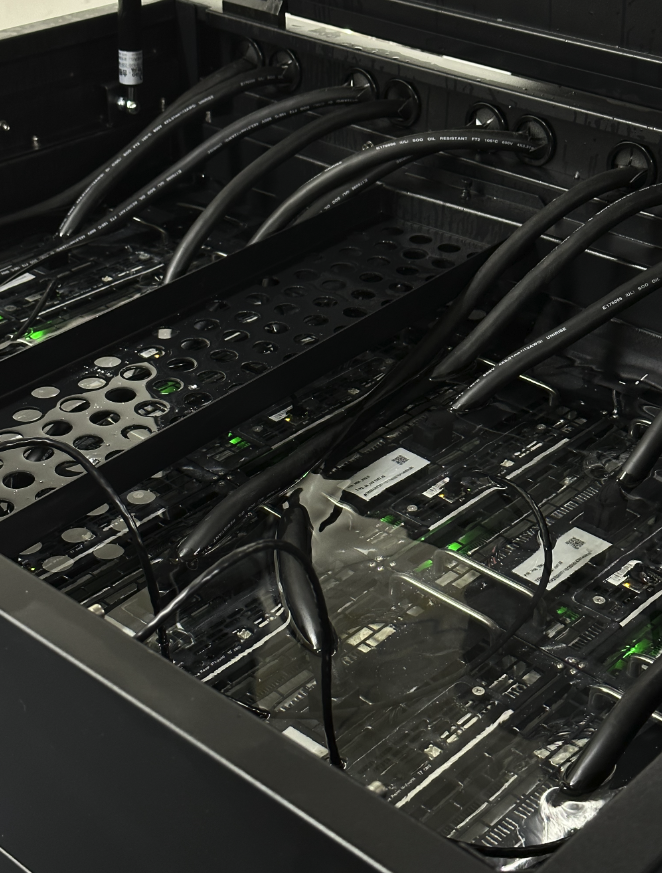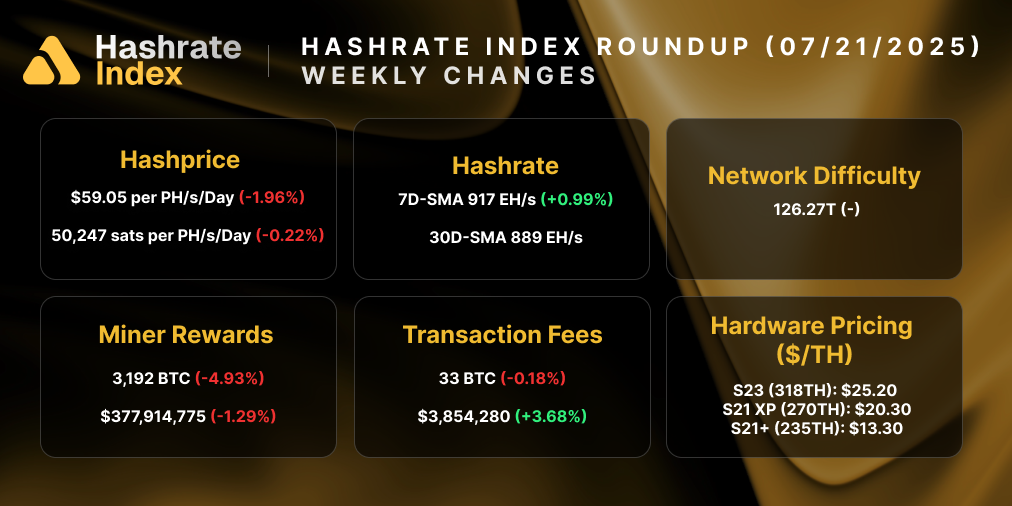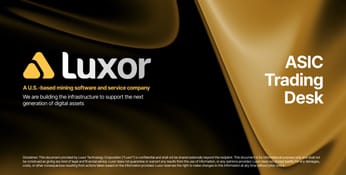
A Look Inside an Immersion and Hydro Cooled Bitcoin Mine
Ever wondered what an immersion or hydro cooling Bitcoin mine looks like? Take a look.
As the 2024 Bitcoin Halving approaches, immersion and hydro Bitcoin mining rigs are growing popular among miners, like MicroBT’s Whatsminer M56, M53 and M33 series.
Recently, the Luxor team had the pleasure of visiting one of MicroBT’s Bitcoin mines in Texas that was fully equipped with hydro and immersion Bitcoin mining rigs. These mines are featured in todays post to illustrate how these setups operate.
We'll also walk through the pros and cons of immersion and hydro cooling mining setups, as well as the ins-and-outs of the hardware needed to run these setups and the special considerations miners must make when operating them.
An Intro to Hydro Cooling and Immersion Bitcoin Mining
As Bitcoin mining becomes more competitive, miners are seeking out more efficient and cost-effective cooling solutions. Immersion cooling and hydro-cooling ASICs have emerged as two promising methods to address these challenges:
- Hydro Cooling: hydro cooling also known as liquid cooling, utilizes cold plate water cooling technology which uses deionized water as the heat transfer medium. Unlike immersion cooling, hydro cooling typically uses a closed-loop system in which water is circulated through heat exchangers without coming into contact with the electrical components. This method allows for efficient heat transfer due to the higher heat capacity of water compared to air and oil. Hydro cooling offers advantages such as improved cooling efficiency, scalability, flexibility, and lower operating costs impact compared to air cooling solutions.
- Immersion Cooling: Immersion cooling involves submerging electronic components, such as servers or ASIC chips, into a non-conductive liquid or coolant. This cooling method enables direct contact between the components and the coolant, providing superior heat dissipation. Immersion cooling offers numerous benefits, including improved cooling efficiency, reduced thermal stress, increased performance, extended equipment lifespan, and a smaller physical footprint. By eliminating the need for air cooling, immersion cooling enables higher-density deployments and reduces noise pollution in computing environments.
The infrastructure supporting immersion and hydro cooling systems share many similarities. The main components of an immersion cooling system include:
- Tank
- Coolant
- Pumps
- Filtration system
- Heat exchangers
- Control system
- Power distribution units (PDUs)
The main components of a hydro cooling system include:
- Racks
- Coolant
- Pump filtration system
- Heat exchangers
- Control system
- Power distribution units (PDUs)
The biggest difference is the coolant being used in the systems (water vs dielectric oil or similar non-conductive fluid).
Hydro cooling systems employ special deionized water as the coolant. Maintaining water quality and minimizing environmental impacts are crucial aspects of hydro mining setups. Miners employ a number of technologies and practices to keep their hydro Bitcoin miners tuned up, such as filtration systems for sediment and debris removal, regular water quality testing, pH adjustment, contaminant removal through chemical treatment, and adherence to environmental factors. Implementing water recycling and reuse systems helps reduce water consumption, and compliance with local regulations ensures proper discharge management. During the tour, MicroBT recommended using first-level deionized water meeting national standard GM/T 6682-2008.
In an immersion cooling system, the fluid must be non-conductive because it comes into direct contact with the ASIC components. The selection of coolant depends on various factors like dielectric properties, thermal conductivity, and compatibility with electronic components. Miners commonly use fluorocarbon-based fluids, such as 3M, Novec, or Galden in immersion cooling systems given their non-conductive nature and high boiling points. These coolants allow for efficient heat transfer while ensuring the safety of the submerged components.
MicroBT’s M33, M53, and M56 Series On Display
Last week Luxor team had the opportunity to visit MicroBT's liquid cooling showroom in Houston, Texas, where MicroBT showcased their latest immersion and hydro-cooling solutions for Bitcoin mining: the Whatsminer M53 and M33 series.
MicroBT’s Latest Hydro Cooling Models: The M33 and M53
Upon entering the liquid-cooled showroom at MicroBT, we immediately noticed the unusual absence of noise, a stark contrast to the typical bustling atmosphere of a Bitcoin mine that relies on air-cooling. In such air-cooling sites, the overwhelming sound of fans often drowns out any effort at conversation.
During our visit, we examined the latest hydro MicroBT ASICs. The 800kW hydro-cooled mining system housed the M33 series (which includes the M33S+ 34J/T and M33S++ 31J/T) and the M53 series (which includes the M53 29J/T, M53S 26J/T, M53S+ 24J/T, and M53S++ 22J/T), released in December 2022 and May 2023 respectively. The real show, however, came from MicroBT’s soon-to-be-released hydro model…
MicroBT also gave a special demonstration (pictured below) of the highly anticipated M53S++ model. The team overclocked this model to a mind-blowing hashrate of over 360TH/s.
Conventional air-cooled Bitcoin mining data centers are bulky and take up a lot of space. One of the many benefits of a hydro setup is higher energy density. For example, a typical 40ft mobile data center container has a capacity of around 1 MW, but we could fit a hydro setup that consumers the same amount of into just 5 of these 2.6ft * 3.3ft * 6.7ft - 200kW hydro server racks.
The hyrdo system can decrease a mining operation’s property footprint drastically. Moreover, the hashrate density of these power-packed hydro mining racks is impressive. One rack of 20 units of M53 hydro miners can produce around 5 PH/s. To achieve the same hashrate with air-cooled miners, you would need 40-50 machines, along with rack space and effective heat exhaust fans. Heatcore’s slick rack design is made to blend right in with traditional data center equipment.
In addition to the impressive hashrate density of each hydro unit's server rack, MicroBT partnered with Heat Core to produce an outstanding feature that sets it apart from other comparative products: it gives you the option to use three different external heat exchanger options including, a water cooler, air cooler, or cooling tower. This flexibility allows miners to custom-build their mines to fit the surrounding resources and environment.
For home miners, there is also an intriguing hydro option combining Bitcoin mining and space heating. MicroBT, in collaboration with Heat Core, presents the HS20 hydro container that is specifically designed to accommodate 2 MicroBT hydro units, allowing home miners to not only mine Bitcoin but also utilize the warm water for their homes up to 200㎡ (or swimming pools of up to 40㎡) with a heating capacity of 17200 kcal/h. With a noise level of 55 dB at a distance of 1 meter, the container produces a moderate noise comparable to that of a residential street or a normal conversation between two people.
MicroBT’s Immersion Models: The M56 and M53S++
Moving onto the immersion setup - the immersion cooling system was equipped with the Whatsminer M56 model class, which was released January this year as MicroBT’s first immersion-specific model. These machines have a hashrate range of 168 to 194 TH/s with an efficiency of 29 J/T. Running in the recommended Shell S5X/S3X coolant with a ≥24L/min SLM, they run with remarkable quietness and sleek efficiency inside the immersion tanks.
Recycling Bitcoin Mining Waste Heat
As evidenced by Heat Core and MicroBT’s partnership, adoption of hydro and immersion cooling technologies can yield secondary benefits like heat cost reduction through Bitcoin mining waste heat recapture.
An example of the utility of Bitcoin mining waste heat:
In October 2022, MicroBT partnered with Heat Core to launch a hydro-cooling and heat recovery pilot project at Titan Energy Park in Bellefonte, Pennsylvania. The pilot showcases different heating scenarios, such as fish hatcheries, hydroponics, and space heating, powered by the heat generated by MicroBT's integrated energy and mining systems. MicroBT is making a clear push toward heat reuse applications with these systems.
Bitcoin mining generates a substantial amount of heat as a byproduct of the computational processes. This heat can be repurposed for various applications, including space heating, where the excess heat is redirected to warm nearby buildings or facilities, reducing the need for traditional heating systems. Miners can also use it for greenhouses, indoor farming, aquaculture systems, and fish farms.
Industrial processes, such as manufacturing or drying, can benefit from the excess heat, reducing energy consumption. Additionally, integrating mining-generated heat into district heating systems (as North Vancouver has already done) can provide cost-effective and sustainable heating solutions for entire communities.
What is MicroBT?
Founded in 2016, MicroBT produces the Whatsminer Bitcoin mining ASIC series, a highly sought-after line of Bitcoin mining ASICs known for their durability and longevity. Given their quality and reliability, miners around the world operate MicroBT's Bitcoin miners.
Luxor’s ASIC Trading desk noted substantial volumes for MicroBT’s hardware in Q2 2023. Over the quarter, Whatsminers represented over 33% of the total traded volume on Luxor’s ASIC RFQ, and they represented 25% of the total volume for Luxor’s OTC trading desk. The combined volume is a 106% increase compared to the previous quarter. This trend further exemplifies MicroBT's enduring appeal and the growing demand for their cutting-edge mining equipment, especially during the heated summer season.
Ever since the debut of the MicroBT first Bitcoin ASIC ——Whatsminer M3 in 2017, the company has dedicated its efforts to manufacturing Bitcoin ASICs utilizing Samsung as its chip foundry. Below showcases the key MicroBT Bitcoin ASIC models with release timelines:
With the 2024 Bitcoin Halving Near, Immersion and Hydro Bitcoin Mining Become More Relevant
The 2024 Bitcoin halving is 9 months away, and miners will need every bit of hashrate and every ounce of efficiency gains they can get to remain competitive when Bitcoin’s block subsidy is halved.
Immersion and hydro cooling Bitcoin mining setups will continue to represent an increasing percentage of total active hashrate as miners plan for the future. We'll be keeping an eye on these technologies at Luxor, and the team at Hashrate Index plans to devote time to research on ASIC immersion and hydro cooling in the year to come.
Hashrate Index Newsletter
Join the newsletter to receive the latest updates in your inbox.








